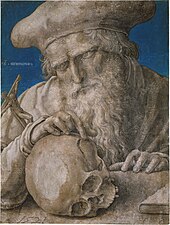Human skull symbolism

Skull symbolism is the attachment of symbolic meaning to the human skull. The most common symbolic use of the skull is as a representation of death, mortality and the unachievable nature of immortality.
Humans can often recognize the buried fragments of an only partially revealed cranium even when other bones may look like shards of stone. The human brain has a specific region for recognizing faces,[1] and is so attuned to finding them that it can see faces in a few dots and lines or punctuation marks; the human brain cannot separate the image of the human skull from the familiar human face. Because of this, both the death and the now-past life of the skull are symbolized.
Hindu temples and depiction of some Hindu deities have displayed association with skulls.
Moreover, a human skull with its large eye sockets displays a degree of neoteny, which humans often find visually appealing—yet a skull is also obviously dead, and to some can even seem to look sad due to the downward facing slope on the ends of the eye sockets. A skull with the lower jaw intact may also appear to be grinning or laughing due to the exposed teeth. As such, human skulls often have a greater visual appeal than the other bones of the human skeleton, and can fascinate even as they repel. Our present society predominantly associates skulls with death and evil.
Unicode reserves character U+1F480 (